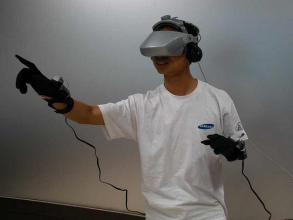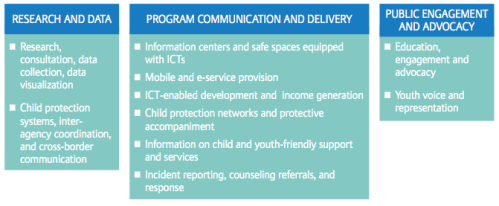by Hila Mehr and Linda Raftree
On March 31, 2015, nearly 40 participants, joined by lead discussants Robert Fabricant, Dalberg Design Team; Despina Papadopoulos, Principled Design; and Roop Pal, PicoSatellite eXploration Lab; came together for Technology Salon New York City where we discussed the future of wearables in international development. As follows is a summary of our discussion.
While the future of wearables is uncertain, major international development stakeholders are already incorporating wearables into their programs. UNICEF Kid Power is introducing wearables into the fight against malnutrition, and is launching a Global Wearables Challenge. The MUAC (mid-upper arm circumference) band already exists in international health. Other participants present were working on startups using wearables to tackle global health and climate change.
As Kentaro Toyama often says “technology is an amplifier of human intent” and the Tech Salon discussion certainly resonated with that sentiment. The future of wearables in international development is one that we–the stakeholders as consumers, makers, and planners–will create. It’s important to recognize the history of technology interventions in international development, and that while wearables enable a new future, technology interventions are not new; there is a documented history of failures and successes to learn from. Key takeaways from the Salon, described below, include reframing our concept of wearables, envisioning what’s possible, tackling behavior change, designing for context, and recognizing the tension between data and privacy.
Reframing our Concept of Wearables
Our first discussant shared historical and current examples of wearables, some from as far back as the middle ages, and encouraged participants to rethink the concept of wearables by moving beyond the Apple Watch and existing, primarily health-related, use cases. While Intel, Arm, and Apple want to put chips on and in our bodies, and we think these are the first cases of wearables, glasses have always been wearable, and watches are wearables that change our notions of time and space. In short, technology has always been wearable. If we stay focused on existing, primarily luxury, use cases like FitBit and Apple Watch, we lose our creativity in new use cases for varying scenarios, he said.
In many cases of technology introduction into a ‘developing world’ context, the technology adds a burden rather than contributing ease. We should be thinking about how wearables can capture data without requiring input, for example. There is also an intimacy with wearables that could eliminate or reframe some of the ingrained paradigms with existing technologies, he noted.
In the most common use cases of wearables and other technology in international development, data is gathered and sent up the chain. Participants should rethink this model and use of wearables and ensure that any data collected benefits people in the moment. This, said the discussant, can help justify the act of wearing something on the body. The information gathered must be better incorporated into a personal-level feedback loop. “The more intimate technology becomes, the greater responsibility you have for how you use it,” he concluded.
In the discussion of reframing our notion of wearables, our second discussant offered a suggestion as to why people are so fascinated with wearables. “It’s about the human body connected to the human mind,” she explained. “What is it to be human? That’s why we’re so fascinated with wearables. They enlarge the notion of technology, and the relationship between machine, human, and animal.”
Envisioning What’s Possible
In discussing the prominent use of wearables for data collection, one participant asked, “What is possible to collect from the body? Are we tracking steps because that is what we want to track or because that is what’s possible? What are those indicators that we’ve chosen and why?”
We need to approach problems by thinking about both our priorities and what’s possible with wearable technology, was one reply. “As consumers, designers, and strategists, we need to push more on what we want to see happen. We have a 7-year window to create technology that we want to take root,” noted our lead discussant.
She then shared Google Glass as an example of makers forgetting what it is to be human. While Google Glass is a great use case for doctors in remote areas or operators of complex machinery, Google Glass at dinner parties and in other social interactions quickly became problematic, requiring Google to publish guidelines for social uses cases. “It’s great that it’s out there as a blatant failure to teach other designers to take care of this space,” she said.
Another discussant felt that the greatest opportunity is the hybrid space between specialized and the generalized. The specialized use cases for wearables are with high medical value. And then there are the generalized cases. With expensive and new technology, it becomes cheaper and more accessible as it meets those hybrid use cases in-between specialized and generalized to justify the cost and sophistication of technology. Developing far out and futuristic ideas, such as one lead discussant’s idea for a mind-controlled satellite, can also offer opportunities for those working with and studying technology to unpack and ‘de-scaffold’ the layers between the wearable technology itself and the data and future it may bring with it.
Tackling Behavior Change
One of the common assumptions with wearables is that our brains work in a mechanical way, and that if we see a trend in our data, we will change our behavior. But wearables have proven that is not the case.
The challenge with wearables in the international development context is making sure that the data collected serves a market and consumer need — what people want to know about themselves — and that wearables are not only focused on what development organizations and researchers want to know. Additionally, the data needs to be valuable and useful to individuals. For example, if a wearable tracks iron levels but the individual doesn’t understand the intricacies of nutrition, their fluctuations in iron levels will be of no use.
Nike Plus and its FuelBand has been one of the most successful activity trackers to date, argued one discussant, because of the online community created around the device. “It wasn’t the wearable device that created behavior change, but the community sharing that went with it.” One participant trained in behavioral economics noted the huge potential for academic research and behavioral economists with the data collected from wearables. A program she had worked on looked closely at test-taking behaviors of boys versus those of girls, and wearables were able to track and detect specific behaviors that were later analyzed and compared.
Designing for Context
Mainstream wearables are currently tailored for the consumer profile of the 35-year-old male fitness buff. But how do we think about the broader population, on the individual and community level? How might wearables serve the needs of those in emergency, low resource, or conflict settings? And what are some of the concerns with wearables?
One participant urged the group to think more creatively. “I’m having trouble envisioning this in the humanitarian space. 5-10 years out, what are concrete examples of someone in Mali, Chad, or Syria with a wearable. How is it valuable? And is there an opportunity to leapfrog with this technology?”
Humanitarian disaster contexts often face massive chaos, low literacy rates, and unreliable Internet connectivity, if Internet exists at all. How can wearables be useful in these cases? One participant suggested they could be used for better ways of coordinating and organizing — such as a warning siren signal wearable for individuals in warzones, or water delivery signal wearable for when water arrives — while keeping in mind real restrictions. For example, there are fears today about vaccines and other development agency interventions. This may escalate with wearable devices or edible tracking devices.
No amount of creativity, however, replaces the realistic and sustainable value of developing technology that addresses real needs in local contexts. That’s where human-centered design and participatory processes play a vital role. Wearable products cannot be built in isolation without users, as various participants highlighted.
As one lead discussant said, we too often look at technology as a magic bullet and we need to avoid doing this again when it comes to wearables. We can only know if wearable technology is an appropriate use case by analyzing the environment and understanding the human body. In Afghanistan, she noted, everyone has an iPhone now, and that’s powerful. But not everyone will have a FitBit, because there is no compelling use case.
Appropriate use cases can be discovered by involving the community of practice from day one, making no assumptions, and showing and sharing methodology and processes. Makers and planners should also be wary of importing resources and materials, creating an entire new ecosystem. If a foreign product breaks with no access to materials and training, it won’t be fixed or sustainable. Designing for context also means designing with local resources and tailored to what the community currently has access to. At the same time, international development efforts and wearable technology should be about empowering people, and not infantilizing them.
The value of interdisciplinary teams and systems maps cannot be overlooked, participants added. Wearables highlight our individual-centric nature, while systems thinking and mapping shows how we relate with ourselves, our community, and the world. Thinking about all of these levels will be important if wearables are to contribute to development in a positive way.
Tensions around Privacy, Data, and Unethical Uses
Wearables exist in tension with identity, intimacy, and privacy. As consumers, users, makers, and planners of wearables, we have to think critically and deeply about how we want our data to be shared. One discussant emphasized that we need to involve VCs, industry, and politicians in discussion around the ethical implications of wearable technology products. The political implications and erosion of trust may be even more complex in developing world contexts, making a consortia and standards even more necessary.
One participant noted the risks of medical wearable technology and the lack of HIPAA privacy requirements in other countries. The lack of HIPAA should not mean that privacy concerns are glossed over. The ethics of testing apply no matter the environment, and testing completely inappropriate technology in a developing context just for the captive audience is ethically questionable.
Likewise, other participants raised the issue of wearables and other types of technology being used for torture, mind control and other nefarious purposes, especially as the science of ‘mind hacking’ and the development of wearables and devices inserted under the skin becomes more sophisticated.
Participants noted the value in projects like the EU’s Ethics Inside and the pressure for a UN Representative on privacy rights. But there is still much headway to be made as data privacy and ethical concerns only grow.
The Future We Wear
The rapid evolution of technology urges us to think about how technology affects our relationships with our body, family, community, and society. What do we want those relationships to look like in the future? We have an opportunity, as consumers, makers and planners of wearables for the international context to view ourselves as stakeholders in building the future opportunities of this space. Wearables today are where the Internet was during its first five mainstream years. Now is the perfect time to put our stake in the ground and create the future we wish to exist in.
***
Our Wearables and Development background reading list is available here. Please add articles or other relevant resources or links.
Other posts about the Salon, from Eugenia Lee and Hila Mehr.
Many thanks to our lead discussants and participants for joining us, and a special thank you to ThoughtWorks for hosting us and providing breakfast!
Technology Salons run under Chatham House Rule, therefore no attribution has been made in this summary post. If you’d like to join future Salons to discuss these and related issues at the intersection of technology and development, sign up at Technology Salon.








![M4 Version 5[4]](https://lindaraftree.files.wordpress.com/2013/06/m4-version-54.jpg?w=240&h=382)

 The February 5 Technology Salon in New York City asked “
The February 5 Technology Salon in New York City asked “
